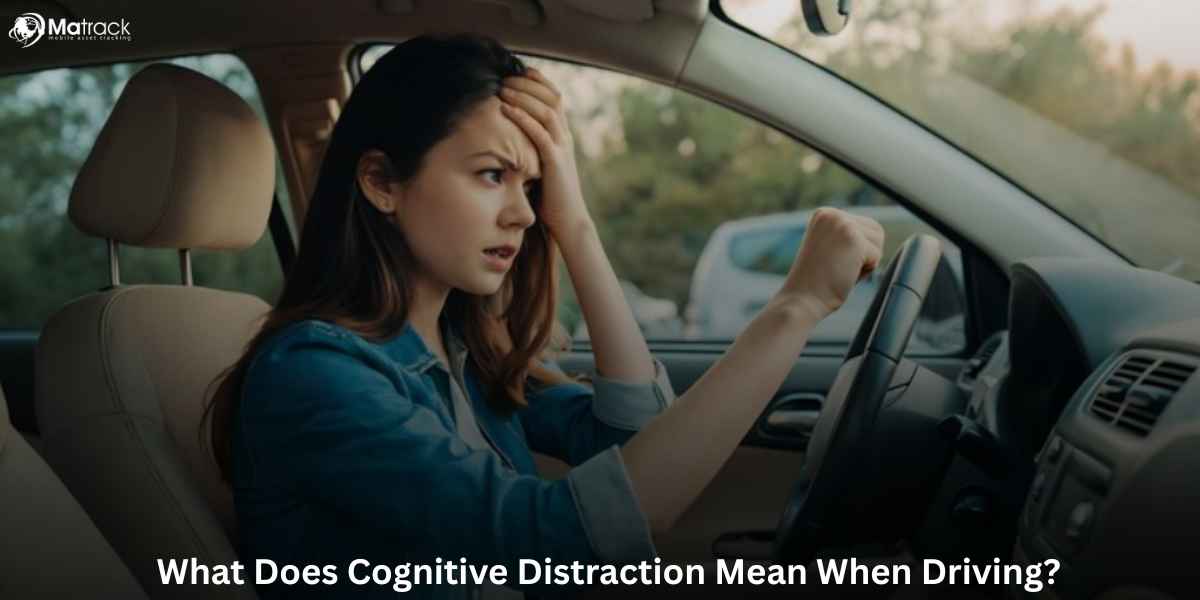Key Takeaways
- Cognitive distraction happens when a driver’s mind shifts from driving to unrelated thoughts, reducing focus and increasing crash risk.
- It weakens situational awareness, slows reaction time, and causes drivers to miss critical road cues without realizing it.
- Common examples include hands-free calls, emotional stress, and internal planning that divert mental attention.
- Prevention methods like mindful driving, reducing conversations, and tools like Matrack’s GPS tracking and fleet dash cam can help keep focus on the road.
What Is Cognitive Distraction ?
Cognitive distraction is any mental activity that takes a driver’s attention away from the road and the task of driving. It makes the brain focus on thoughts instead of traffic, signals, or surrounding vehicles.
According to the National Highway Traffic Safety Administration (NHTSA), cognitive distraction is a major reason drivers miss important cues. Thinking about problems, talking on a hands-free call, or planning something while driving slows down reaction time and increases crash risk.
What Is The Science Behind Cognitive Distraction?
Driving depends on constant mental focus to handle visual details, track movement, and respond to traffic around the vehicle. When the mind shifts to another thought or task, even briefly, the brain loses grip on what’s happening on the road.
The brain doesn’t multitask complex actions, it switches between them, leaving gaps in awareness. These mental shifts make it harder to notice changes, react quickly, or remember what just happened on the road.
What Are The Different Types of Cognitive Distraction?
Cognitive distraction has four major forms:
- Passive distraction: Mild disengagement, such as zoning out or daydreaming
- Active internal dialogue: Thinking about work, to-do lists, or personal issues
- Emotional disruption: Processing feelings or memories that absorb mental focus
- Conversation load: Engaging in complex dialogues via hands-free systems or with passengers
Why Cognitive Distraction Is So Dangerous?
Reduced Situational Awareness
Cognitive distraction breaks the connection between what the eyes see and what the brain registers. A distracted mind often overlooks pedestrians, vehicles, or road signs, even when they’re directly in view. This mental absence increases the chance of missing critical road cues.
Delayed Reaction Time
When the brain is divided between driving and internal thoughts, it responds more slowly to unexpected events. A slight delay in braking or steering can turn a minor situation into a serious accident, especially in high-speed traffic or sudden hazards.
Missed Road Signals
Distraction weakens short-term memory and selective attention, causing drivers to forget or ignore important signs. Stop signs, speed limits, or detour warnings might be seen but not processed, leading to wrong turns or dangerous maneuvers.
False Sense of Control
Drivers often believe they are focused simply because they’re physically present. But when their mind is elsewhere, they underestimate the risk and continue driving without adjusting behavior or slowing down.
Hidden and Prolonged Risk
Cognitive distraction is dangerous because it’s invisible and often goes unnoticed. Unlike texting or eating, it doesn’t involve movement or noise, allowing it to persist for long periods while silently increasing crash risk.
What Are The Examples Of Cognitive Distraction?
Hands-Free Phone Conversations
Talking on the phone, even with a hands-free device, splits mental attention. The brain focuses on listening, forming responses, and maintaining conversation flow—diverting critical mental resources away from driving.
Daydreaming and Overthinking
Letting the mind wander into thoughts about work, relationships, or future plans creates a mental gap. This shift removes the driver’s focus from the present road environment, delaying reactions and reducing awareness.
Emotional Distractions
Processing strong emotions like anger, sadness, or anxiety consumes mental energy. A driver dealing with emotional stress is less alert and more prone to overlooking signals or making impulsive decisions.
Talking to Passengers
Engaging in deep or emotional conversations inside the car can cause cognitive overload. The more intense the discussion, the more likely the driver’s attention is mentally drawn away from the road.
Mental Rehearsals and Planning
Rehearsing speeches, thinking through problems, or mentally organizing tasks pulls attention inward. Although there’s no physical distraction, the mental load significantly weakens driving performance.
Also See: How To Become A Truck Driver?
How to Prevent Cognitive Distraction?
Pre-Drive Mental Preparation
Start every drive with a clear and focused mind. Resolve emotional stress, delay planning or problem-solving, and mentally shift full attention to the road before you begin driving.
Limit Conversations Behind the Wheel
Keep verbal interaction to a minimum while driving. Avoid deep discussions or emotional topics, and if a phone call is necessary, keep it short and to the point, even with hands-free systems.
Choose Calming, Non-Distracting Audio
Play soft instrumental music or keep the car environment quiet. Avoid content like podcasts or audiobooks that demand focus or provoke emotional reactions, as they divide attention.
Practice Mindful Driving Techniques
Train your mind to stay present throughout the journey. Use active awareness methods such as silently identifying road signs, noting actions of nearby vehicles, or describing surroundings to stay engaged.
Take Scheduled Mental Breaks
Break long drives into manageable segments to maintain mental sharpness. Stop every 90 to 120 minutes for a quick walk or hydration, this resets mental focus and helps prevent fatigue-related distraction.
Use In-Vehicle Monitoring Technology
Rely on vehicles equipped with driver monitoring systems for added safety. These systems detect signs of cognitive distraction through eye tracking, head movement, and blinking patterns, issuing alerts when attention drops.
Enroll in Driver Awareness Programs
Stay informed through defensive driving courses and safety workshops. Many programs now include training on mental distractions, helping drivers recognize signs early and respond with practical solutions.
Consequences of Ignoring Cognitive Distraction
Accidents and Injuries
Cognitive distraction often leads to serious driving errors with real-world consequences. Drivers who are mentally disengaged can miss critical signals, react too late, or misjudge traffic—causing crashes that result in injury or even loss of life.
Legal Liability
Mental distraction, even when not obvious, can still be treated as negligence under the law. In many cases, if a driver is found to be mentally unfocused during an incident, they can be held legally responsible, especially if their lack of attention contributed to the accident.
Insurance and Financial Loss
The financial impact of distraction-related crashes extends far beyond vehicle damage. Drivers may face higher insurance premiums, detailed investigations, and potential legal fees, particularly when cognitive distraction is identified as a contributing factor.
How Matrack Helps You Drive Safely on the Road?
Matrack’s GPS fleet tracking helps drivers stay focused by cutting out the need for constant calls or check-ins. Since the system shows routes and vehicle updates live, drivers can just drive without distractions.
The fleet dash cam makes a big difference by keeping drivers aware of their habits on the road. When they know their driving is being recorded, they’re more likely to stay alert and avoid losing focus.
It also sends instant alerts if something like hard braking or sharp turning happens. These quick reminders help drivers stay present and correct unsafe actions right away.



